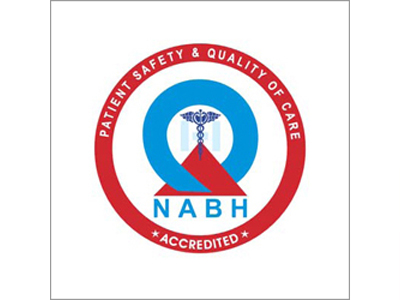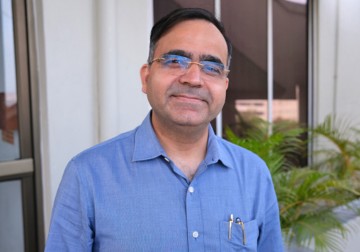Herpes simplex keratitis (HSK) is a corneal inflammatory disease caused by herpes simplex virus (HSV) infection of the eye. The disease often involves corneal scarring, edema, necrosis, and eventually blindness. Despite being a common cause of corneal blindness, data indicating the prevalence of HSK in India is scarce. Dr. Bhupesh Bagga, a veteran physician-scientist and head of the Ramoji Foundation Centre for Eye Infections at LVPEI, talks about his latest research paper that uses LVPEI’s electronic medical records to assess the demographic and clinical profile of HSK in patients.
As an ophthalmologist, what are your research interests and how does what you see in the clinic impact your research choices?
Corneal infections are my primary area of research; the subject has always piqued my interest. For 12 years now, I have been doing extensive research in this field, both in vivo (mice and rabbits) and in vitro (human cell lines) models. I see a lot of patients with corneal infections in my outpatient service. Typically, these consist of fungal, bacterial, and viral keratitis (e.g., herpes simplex keratitis). Occasionally, I also receive cases that are relatively difficult to manage, like microsporidia keratitis.
Corneal infections are the most common cause of corneal blindness in India. Owing to their higher occurrence and diverse manifestation in India, I believe, it is the duty of Indian scientists to investigate novel concepts for enhanced detection and management of corneal infections. An Indian scientist such as me has a long way to go, as numerous questions about these diseases remain unanswered. But I am optimistic that one day, India can tell the entire world, ‘Yes, we have developed a much better way to tackle these diseases.’
How did this project start? What were some of the questions that drove you into this research?
LVPEI has been receiving HSK cases since its inception, but there have only been a handful of studies done on the disease. Moreover, statistical data related to HSK have not been well explored in any clinic or institute in India, or even in other developing nations. There is a significant knowledge gap between India and high-income countries in this matter. There are also differences between India and developed nations in how HSK patients are managed. For these reasons, I wanted to examine the number of HSK cases that LVPEI has seen over the previous eight years and provide a description of the clinical characteristics and demographics of these cases.
The paper mentions immune stromal keratitis as the most observed HSK in the cohort. But if you factored in data from primary vision centres of LVPEI, do you think that would change?
According to previous research, the most common kind of HSK in high-income countries is epithelial keratitis, or inflammation of the corneal epithelium. Although prevalent, epithelial keratitis is also easily treated, and in certain cases, the disease is self-resolving. LVPEI has a pyramid-like referral network. Unless there is a risk of vision loss, most epithelial keratitis patients get cured at a lower level and do not end up in tertiary institutes. However, if such instances are considered, or a population-based study is conducted, epithelial keratitis is likely to surpass immune stromal keratitis as the most prevalent form of HSK.
The study shows that the use of topical steroids and acyclovir reduces corneal scarring and oedema over the weeks, yet there is a sharp decline in the use of these medications at the 6-week period. Why?
The observed decline is because of the treatment. Once you start the treatment using steroids and antivirals, the expected response is within six weeks. You end up with noticeably reduced corneal scarring, corneal edema, and as a result, the use of medications also reduces. Hence, you see a sharp decline in these parameters by six weeks.
The study observes that the largest demographic affected by HSK were poor farmers. What are some steps that can be taken to address this public health problem?
I do not think agricultural workers are contracting HSV from work-related trauma. So, it is unlikely that agricultural practices have anything to do with HSK manifestation. It is possible that immunity is the key here. Dormant HSV is often found in the trigeminal ganglion, a cluster of nerves behind our eyes. As a result of stress or other immune system deficiencies, HSV can reactivate and spread to the cornea. However, the workings of those mechanisms are still unclear.
As with any other ocular infection, preventing vision impairment from HSK requires prompt diagnosis and treatment, much like in cases of other ocular infections. Early intervention is largely dependent on public awareness, particularly among rural populations.
What will be this study's impact in predicting HSV keratitis among the populations of Telangana and Andhra Pradesh?
LVPEI's extensive network helped our study include a large sample size of over 8300 patients, which sets it apart from other studies on HSK in India. This work can serve as a springboard for additional investigation into this area. Subsequent research on HSK recurrence based on patient demographics, such as age, occupation, and geography, may aid in defining the disease's clinical characteristics. The study can also be utilized to design strategies for better HSK management.
What is the future direction of your research on HSK?
I am leaning towards experimental research for my future projects. My goal is to find molecular markers in tears that will facilitate a quicker diagnosis of HSK. Furthermore, I aim to investigate the expression of those markers across many follow-ups and create a method that can help predict a patient's risk of HSK recurrence based on their expression value.
Dr. Bhupesh Bagga spoke to Sayantan Mitra, Science Writer, LVPEI. Read more about his research here.
Citation
Das AV, Satyashree G, Joseph J, Bagga B. Herpes simplex virus keratitis: electronic medical records driven big data analytics report from a tertiary eye institute of South India. Int Ophthalmol. 2023 Sep 5



